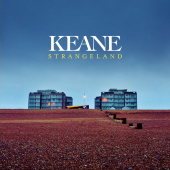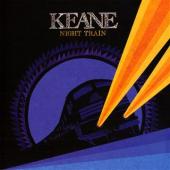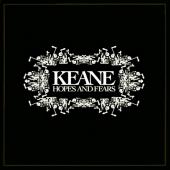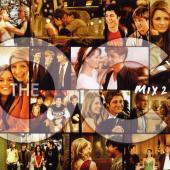Keane are back. After over 8 million sales of Hopes And Fears (2004) and Under The Iron Sea (2006) combined, sold-out arena tours, awards spanning Ivor Novellos to BRITs, plus an undeniable collection of hits including Is It Any Wonder?, Everybody’s Changing, Crystal Ball and Somewhere Only We Know, one of Britain’s best-loved bands are about to surprise and thrill all over again.
Avowed believers in never retreading old ground, Tom Chaplin, Tim Rice-Oxley and Richard Hughes return with Perfect Symmetry, a Technicolor explosion of stellar pop songs and pure, unashamed energy; the joy in which is audible in every finger-click and life-affirming chorus. As different as piano-helmed classic debut Hopes And Fears was from its darker cousin Under The Iron Sea, Perfect Symmetry finds Keane at the height of their powers. Confirming Rice-Oxley’s position as one of the finest British songwriters to emerge this decade, the 11-song set sees Keane throwing any last vestiges of caution to the wind and simply letting the music take them where it will. The result is a thrillingly bold album that’s as pleasurable to listen to as it was to make.
While millions of paid-up Keane fans will immediately recognise Perfect Symmetry as a body of work that could have come from no other group, others are likely to be knocked sideways by their various leaps into uncharted territory. Indeed, after hearing download-record-breaking first taste Spiralling, it’s possible you might not have even recognised it the work of “the Somewhere Only We Know band”. Certainly, Perfect Symmetry is the first Keane album to feature musical saw, saxophone, vocals recorded through a drum; studio sessions in Berlin, Paris and London; their first self produced album, with input from esteemed producers Jon Brion (Rufus Wainwright; Kanye West) and Stuart Price (Madonna; Les Rhythmes Digitales) and the sound of three men yelping a delighted ‘Oooh!’ as virtually the first thing you hear.
“We’ve always said we want to challenge ourselves,” says Hughes. “Most bands, when they release an album, always say they’ve pushed themselves. But we’re all music lovers and we sit there and read these things and think ‘Great, can’t wait to hear it!’ and then you put it on and you think ‘Oh. Hang on a minute…’”
“There’s nothing that our record company would have loved more than for us to have delivered Hopes And Fears three times,” he continues. “But we’ve already done one, and one’s enough.”
“I think by a million miles it’s the best thing we’ve put together,” says Chaplin. “I can’t wait for people to hear it.”
***
Keane wound up the Under The Iron Sea tour on August 5, 2007. A couple of charity gigs aside, they then took time out for family, friends and a well-earned breather, not reconvening again until mid-January 2008. It was to prove the right decision. “With the second record we went straight off the road into the studio when we really needed a break and that sowed the seeds for a lot of problems which have been quite well-documented. We learned from that this time.” says Hughes.
Pooling the first batch of ideas in their ‘Barn’ studio in southern England (somewhere that’s provided a bolthole for the last few years) Keane then decamped to Paris in mid-February, having booked a couple of days recording time with Jon Brion, the maverick producer as regarded for his soundtrack work as that with US pop acts. Though Perfect Symmetry would end up being almost entirely self-produced, Brion’s input in that short time proved revelatory. “We looked at hip-hop records where they have multiple producers and you never get that with pop or rock records,” says Hughes. “That was part of the thinking there, so Jon came to Paris to work with us for three days before setting off to work on the soundtrack for the new Charlie Kaufman movie.”
“Jon coming onboard was a massive influence,” says Rice-Oxley. “We were in a good place already but he gave us the confidence of not thinking; of not self-editing. We were saying that the records we love are the records that, as a musician, you think ‘God, it must have been amazing to be at that session; it must have been really fun’ and his theory was you only get that by just going for it. Not worrying what people are going to think, or even what you’re going to think! Let’s face it: the worst that can happen is that it’s an idea that doesn’t work.” Consequently, Brion and Keane soon found themselves rooting around in the back of the studio for obtuse percussion instruments and recording vocals in all manner of peculiar ways. You can hear the results on the stellar You Haven’t Told Me Anything, one of the most musically ‘out there’ tracks the band have produced to date.
From then it was back to the UK for a couple of weeks before decamping to Teldex Studios in Berlin. It’s a lengthy journey… if you undertake it by train. “We all got on the overnight train and that journey becomes part of the experience,” says Hughes. “You get to go to the bar and just hang out. It was really, really enjoyable, fun and different. We’re desperate to make sure we get out there again as soon as we can, by train.”
The city that had previously inspired them so much on tour – not to say produced such landmark albums in Keane’s formative years as U2’s Achtung Baby and Bowie’s Low – provided another vital cog in the process. Teldex, a massive former ballroom, would help root Perfect Symmetry with its sense of tragic grandeur. It was during this initial visit that Rice-Oxley wrote standout first single proper The Lovers Are Losing and Stuart Price lent his deft production hands for three days, most audibly on Again And Again. A very different worker to Brion, Price proved equally inspirational in underlining that when it comes to experimenting in the studio, basically, there are no wrong answers.
Further songs fell into place between The Barn, Berlin and London’s Olympic Studios over the next few months, with ideas coming so thick and fast that the song Pretend That You’re Alone was being written and recorded in one studio while other album tracks were being mixed in the next.
The result is a huge record made up of songs in the tradition of happy-sad classic British bands from The Beatles onwards. Or, as Hughes has it, “songs that are not that happy but that sound happy.” Pop music that’s anything but throwaway.
Some have already detected an Eighties influence on parts of Perfect Symmetry. If that’s the case, Keane say, it’s in the spirit of adventure, boldness and Big Pop of those times, rather than any attempt at retro pastiche.
“The boldness of that time is something that’s really frowned upon today,” notes Rice-Oxley. “We’re living in a time when it’s cool to be ‘Eighties’ in a retro way, but I don’t think that spirit and unashamed energy of great 1980s pop is particularly prevalent today. If this record sounds like that, it’s probably because I associate some of those songs – Pet Shop Boys, Salt N’ Peppa, Mel & Kim – with a fun, innocent time. I absolutely do not care what is considered to be fashionable or cool or tasteful – it’s much more about following our own instincts.”
***
Great hooks, big choruses and massive middle eights come as a factory setting with Keane, of course, something that’s meant that, previously, Rice-Oxley’s lyrics have sometimes perhaps not been given the attention they deserve. That’s unlikely to prove the case with Perfect Symmetry, which features his most direct, unambiguous and, yes, best words to date. Whether on train-of-thought, Pygmalion-inspired Spiralling, broadside on fame-for-fame’s-sake Better Than This or the title track Perfect Symmetry which brilliantly takes as its theme the futile distractions of the human race (“I think it might be the best song I’ve ever written” says Rice-Oxley, here Big Ideas are never sacrificed on the altar of great tunes.
“I love Better Than This,” agrees Chaplin. “Sonically it’s a big departure, but lyrically, being about the state of ‘celebrity culture’… people see it as such an important thing and pin so much hope on it. Certainly, in my opinion, the fame and celebrity side of things is something I find hard to reconcile. I’d much rather it was just about the music; the reason we got into the band in the first place. It wasn’t to get rich or become famous or to get girls – it was to be out there singing. That magic connection between you and a crowd of people who have turned up to pour everything out, like you have… that coming together is the biggest buzz in my life.”
***
So that’s Keane in 2008: the big gigs, big chart success and big awards we know about; now here’s the album of their career. A big, bold, shiny pop monster that’s as likely to appeal to hearts and minds as it is to feet.
“Because we nearly lost it all, we nearly lost the band and we could have gone our separate ways,” says Chaplin, “we had this reinvention as people. You know, ‘We might not have this, so we might as well enjoy it’. That affected everything that we did with this album.”
No wonder it starts with an ‘Oooh!’
KEANE are:
Tom Chaplin – vocals, etc.
Richard Hughes – drums, etc.
Tim Rice-Oxley – piano, etc.





















